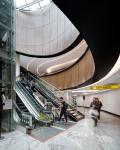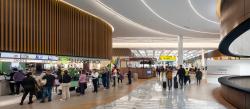The design concept was proposed by the English firm TDS, whose main objective was to increase the profitability of the waiting hall. In addition, they sought to join Hall B and C with the rest of the connecting corridor on the air side, unifying the design with the recently remodeled halls.
Shops were relocated, creating a central access plaza that distributes to the different areas of the project, a watershed to distribute passengers along the terminal, with stepped platforms with lines of light that optimize the existing heights and direct the flow of the route. Different materials were integrated into the floors to identify the various uses that are had along the route, framing the waiting and dining areas with various vinyl floor mats, as well as various retail islands that reinforce the uses along the passenger route.
To create a feeling of greater spaciousness in the terminal, the storefronts were changed, unifying them with clear glass that extends the view of all the corridors to the interior of the stores. Their heights were equalized, integrating wooden panels in those with double heights, giving it greater warmth to frame the different areas throughout the terminal.
The visual finishing touch to the food court is the terrace, a space that took advantage of the existing BHS slab by opening the terminal from the outside to the runways, resulting in a recreation and living area that allows contact with the outside and the comforts of the inside.
The commercial premises, sanitary modules, integrated vegetation and natural lighting creating a comfortable microclimate that invites the user to relax and enjoy an experience unlike any other terminal.
The space is used primarily for services and divided into four main areas focused on different activities: the covered terrace area, dedicated to commercial food and beverage kiosks; the open terrace area, dedicated to recreation and contemplation of the landscape; the restroom area and the infrastructure services area.
The covered terrace area functions as a reception and lobby for the other spaces, and is connected to the food hall, the food court of the domestic terminal. At the center of the space there are commercial kiosks, the bar-type F&B with designer high chairs for serving passengers. To the side of the axis on which the kiosks are located, there are additional tables and bars with the aim of complementing the places and creating areas of coexistence for groups of travelers.
The open terrace area will be located to the south, and is a space for contemplating the landscape with an area of benches and tables overlooking the track. It has a system of automatic pergolas that allow natural ventilation of the space and at the same time serve to protect the interior from the weather conditions.
The ground floor of the project is focused on the connection points between the terminal and the land side. Within these points, the ERPE and National Baggage Claim were worked on.
ERPE of 1,560 S qm with 9 E-Gates, has a surveillance module, a return corridor and a side corridor for oversized access, single lines adaptable to passenger demand and inspection filters divided into two sections: 8 general inspection points and 2 filters for disabled people, crew and families. A post-inspection vestibule that directs passengers either to the authority’s area or to the vertical circulation core that connects to the SUE.
The 3,655.95 s qm National Baggage Claim area has 7 baggage belts, 2 double-height with wooden panels and a large video wall above and 5 with white phenolic panels and illuminated panels; an information point, 6 vehicle rental offices, a storage area and technical rooms hidden within the panels at the back of the belts. A lift for the disabled, a toilet module and 3 airline offices set back from the main flow.
Both spaces are integrated with the materials that compose them. As they are spaces of transit, colder materials were used, which promote flow, but with a timeless materiality of low maintenance, but with a predominant aesthetic.
Granite floors whose reflectance creates a rhythm with the lighting reflections of the ceilings and gives greater spaciousness to the space. Ceilings whose rhythm gives a sensation of greater height in the space, plasterboard borders, modular ceilings and luminous ceilings help us to have a well-lit space that gives greater comfort to the user.
For these areas, direct lighting was considered with indirect lighting reinforcements. To do this, strips of illuminated panels between columns and various boxes on the perimeters were considered in order to provide the appropriate lighting levels for the visual comfort of the users. According to the norm, the living and circulation areas must be within a range of 300 Luxes, so the LED panel was found with sufficient power and lux to reach these levels.
2024
Project name:
Collaborators: Aeropuerto Guadalajara
Category: Institutional
Project:
Serrano
Collaborators: Conceptual Design TDS GAP:
Ing. Alejandro Vallarino Marusich - Director de Infraestructura
Ing. José Ángel Martínez - Director de Red y Negocio Regulado Arq. Edmundo Bolaños Osuna - Asesor Arquitectura Aeroportuaria
Ing. Florencio Sánchez Osuna - Gerente de Proyectos de Infraestructura
Arq. Ivonne Sinai Soto Lara
Executive Design Serrano :
Arq. Juan Pablo Serrano
Arq. Gabriel Cruz Cervantes
Arq. Ricardo Nettel
Arq. Gabriel Pérez Chenge
Arq. Juan Pablo Pérez Vargas
Arq. Emily Mosqueda
Arq. Myriam Huidobro Mendoza
ROD Consulting:
Arq. Montserrat Espinoza
Arq. Moises Gordillo
Architectural Direction
Serrano
Arq. Juan Pablo Serrano
Arq. Gabriel Cruz Cervantes
Arq. Rubén Cambreros Hernández
Arq. Edgar Enrique Ruvalcaba Rodríguez
Construction company: GIA Construcción/Blue Stone / Jay Construcciones
Lighting project: Light Shape
Luis Lozoya, Karina Modeao
Start:
Conclusion: January 31, 2024
Area: 26, 696 sq m
Location: Guadalajara, Jalisco, Mexico
Photography: Jorge Guadarrama
Conceptual Design TDS GAP:
Ing. Alejandro Vallarino Marusich - Director de Infraestructura
Ing. José Ángel Martínez - Director de Red y Negocio Regulado Arq. Edmundo Bolaños Osuna - Asesor Arquitectura Aeroportuaria
Ing. Florencio Sánchez Osuna - Gerente de Proyectos de Infraestructura
Arq. Ivonne Sinai Soto Lara
Executive Design Serrano :
Arq. Juan Pablo Serrano
Arq. Gabriel Cruz Cervantes
Arq. Ricardo Nettel
Arq. Gabriel Pérez Chenge
Arq. Juan Pablo Pérez Vargas
Arq. Emily Mosqueda
Arq. Myriam Huidobro Mendoza
ROD Consulting:
Arq. Montserrat Espinoza
Arq. Moises Gordillo
Architectural Direction
Serrano
Arq. Juan Pablo Serrano
Arq. Gabriel Cruz Cervantes
Arq. Rubén Cambreros Hernández
Arq. Edgar Enrique Ruvalcaba Rodríguez











